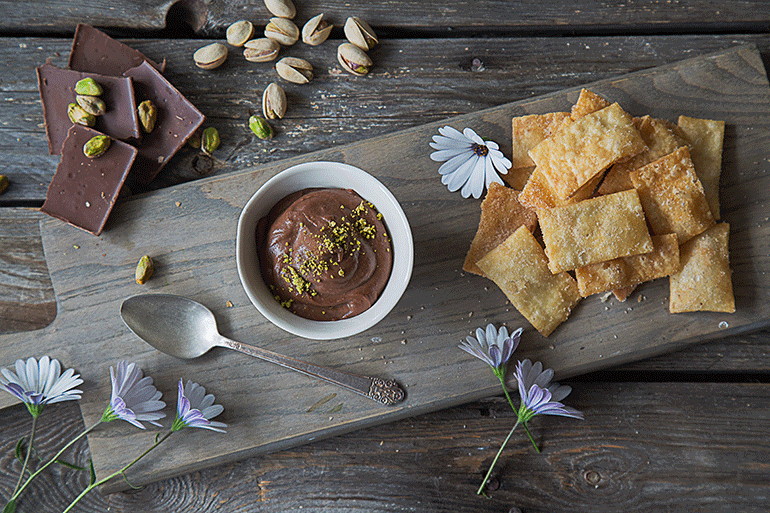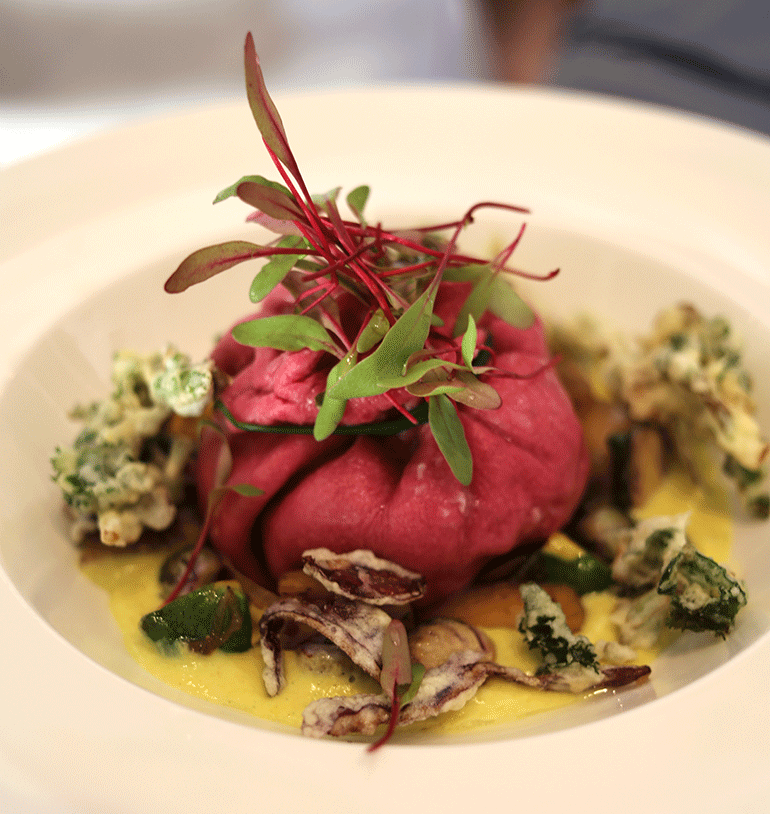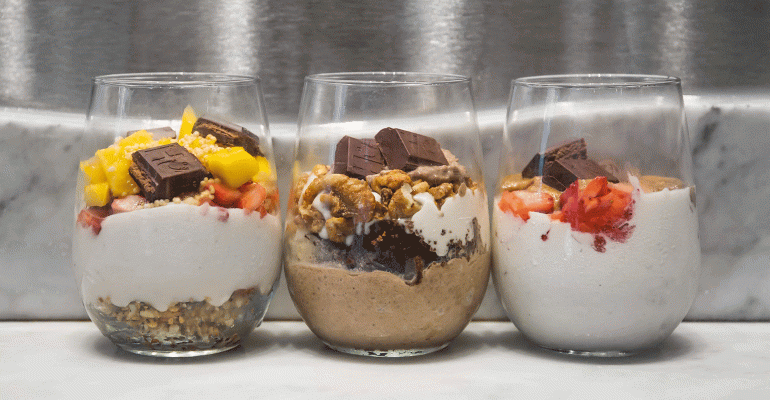Desserts will get a ‘better-for-you’ spin
People love getting permission to eat what they love, and so an array of sweetened superfoods is finding its way onto menus. That includes The Hummus & Pita Co.’s line of dessert hummus — heavily sweetened and with chocolate or cookie dough added. (They also introduced a pumpkin-spice hummus shake this fall).
It also includes gluten-free alfajores — a type of sandwich cookie — at Tanta, a Peruvian restaurant in Chicago that also sprinkles its chocolate mousse with toasted quinoa.

Hu Kitchen, a health-focused fast-casual restaurant in New York City (the “Hu” is pronounced like the first syllable in “human”), has an entire “Mashbar” where guests can assemble their own sweet not-terrible-for-you concoctions, or order curated ones, like the Taro Trouble No-Yo made with grain-free granola, taro pudding, seasonal berries (organic, of course), mango and organic puffed quinoa, or the Bonita, which has almond butter, grain-free granola, cashew cream and organic strawberries.
This is a trend with genuine legs as consumers continue to seek any excuse to indulge. If that means drizzling your ice cream with olive oil or adding chia seeds to your milkshakes, then so be it.
Cold brew will see backlash
Cold brew coffee is here to stay, and will very likely become much more widespread in 2019. Many consumers like its smoothness, its hints of chocolate and its implicit sweetness, and manufacturers have figured out how to make a very consistent product and are delivering it in kegs or in concentrate to restaurants, bars and coffeehouses.

But some coffee aficionados are striking back, complaining that cold brew — made by soaking ground beans in cold water for 16 hours or more — doesn’t properly extract the more distinctive flavors of really good coffee, leaving the terroir behind in the beans. Add to that new machines that can quickly chill hot-brewed coffee to whatever temperature operators like, and you have a convenient alternative that, cold brew detractors argue, lets coffee be served cold and quickly without diminished quality.
The anti-cold brewers are building some momentum, putting forward arguments that hot-brewed coffee is better for you — one study showed it has more antioxidants than cold brew — so more hot-brewed cold coffees are likely to join the marketplace in 2019. Then, consumers will decide what they like best.
Oat milk will be the hot dairy alternative
Dairy-free, nut-free, possibly gluten-free (depending on where the oats are processed), this milk substitute is drawing fans with its texture that’s creamier than most of its counterparts. It also has more protein than nut milks (but less than soy milk or actual milk) and more fiber than any of them.

Oat milk is becoming more commonplace in coffeehouses, and it’s showing up on menus, too, like at Protein Bar, a chain of about 20 units based in Chicago, where the Big Date is a blend of dates, cocoa nibs, banana, vanilla whey protein and oat milk.
There are broader trends driving the oat milk craze: The Coca-Cola Co., citing Mintel data, reported that 36 percent of consumers said they would buy coffee with non-dairy milk, and 35 percent said they’d like coffee with added protein.
The trend will get an additional boost when PepsiCo launches an “Oat Beverage” under the Quaker brand in January.
Lagers will see love again
Maybe it was sour beer that drove craft beer lovers and producers over the edge — that made them say, “You know what? It might be nice to have a beer that I don’t have to think about in order to enjoy.” Maybe hop bombs and brews infected with bacteria aren’t the be all and end all of what’s available from fermented malted grain.
These days craft brewers are talking about clean, crisp lagers.

American consumers never actually strayed too far from lagers. Despite the rapid growth of craft beer in general and India pale ales in particular, craft beer’s share of the national beer market is only around 12.7 percent by volume and 23.3 percent in dollar terms, according to the Brewers Association, the trade body of independent craft brewers.
Now those independent brewers are increasingly turning to what is arguably the most difficult beer to brew well. Lagers don’t have many funky or floral hops to hide behind and can’t be sweetened up with extra malt. They have to be balanced and easy drinking. A growing number of craft brewers are trying their hands at it — some have been doing it for years — and consumers are likely to respond.
— Bret Thorn, food & beverage editor
We got the beet: The root vegetable will be everywhere
Beets are popping up (or taking root, should we say) on a vast cross-section of menus, from buddha bowls to beverages and beggar’s purses. The Little Beet, a gluten-free chain with nine units on the East Coast, is making a name for itself with beets at the forefront. And while deep ruby beets make an indelible impression, golden beets are stepping into the spotlight too, as in the beets and lentils side dish from The Little Beet.

Beets are part of the plant-forward movement as well (think “spaghetti and beet balls”) with their blood-like attributes.
Rootsy though they may be, beets can be elegant too. At a recent chef summit in Monterey, Calif., put on by the Markon Cooperative and the Mushroom Council, beets stole the show with beggars’ purses that recall the glamorous world of 1980s haute cuisine with an eye towards the sustainable, down-to-earth future plans of culinarians.
In addition, beets in liquid form are adding their earthy touch in juices and smoothies, able to go savory or mingle with sweet components like banana or vanilla almond milk.
— Tara Fitzpatrick, senior editor
Sea vegetables will gain a toehold in the U.S.
Asian and European diners have grown accustomed to seeing seaweed — or sea vegetables, as they are also known — on their finer dining menus, and U.S. customers are starting to ride the wave of popularity.
Seaweed consumption is growing 7 percent annually in the United States, according to James Griffin, an associate professor at Johnson & Wales University.
“Sea vegetables in the higher level of dining have been growing rapidly over the past 10 years — and over the past three incredibly fast,” the educator at the Providence, R.I.-based university told an NRA Show audience in May.

“It’s an umami bomb,” Griffin said. “The secret behind all that is that it has a high level of glutamic acid, which is in the flavor enhancer MSG [monosodium glutamate], and it’s found in a natural form in almost all sea vegetables.” Seaweed also includes naturally occurring sea salt, he said, as well as other minerals.
Griffin said chef Rene Redzepi at Noma in Copenhagen is using seaweed in a variety of ways. At Smyth in Chicago, chefs John Shields and Karen Urie Shields have earned two Michelin stars with such sea vegetable creations as a Sea Lettuce Cookie amuse bouche.
“For chefs,” Griffin said, “this is something sexy. It’s something exciting, and something we don’t work with all that often.”
It can be purchased fresh or dried, with the dry version being the most common. About 90 percent of the seaweed consumed in the United States is imported from Asia.
Sea vegetables are highly sustainable, with the typical six- to eight-month farming span done without fertilizer, pesticides, herbicides or feed.
— Ron Ruggless, senior editor
Read more:
3 operations trends for 2019
3 restaurant tech predictions for 2019
5 culinary predictions from industry experts
16 predictions for the restaurant industry in 2019

